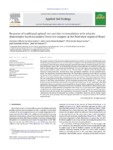Por favor, use este identificador para citar o enlazar este ítem:
http://www.alice.cnptia.embrapa.br/alice/handle/doc/955171| Título: | Response of traditional upland rice varieties to inoculation with selected diazotrophic bacteria isolated from rice cropped at the northeast region of Brazil. |
| Autor: | ARAÚJO, A. E. da S.  BALDANI, V. L. D.   GALISA, P. de S.   PEREIRA, J. A.   BALDANI, J. I.   |
| Afiliación: | ANTONIO EDILSON DA SILVA ARAÚJO, UNIVERSIDADE FEDERAL DE RORAIMA; VERA LUCIA DIVAN BALDANI, CNPAB; PÉRICLES DE SOUZA GALISA, UFRRJ/ Embrapa Agrobiologia; JOSE ALMEIDA PEREIRA, CPAMN; JOSE IVO BALDANI, CNPAB. |
| Año: | 2013 |
| Referencia: | Applied Soil Ecology, v. 64, p. 49-55, 2013. |
| Descripción: | The largest numbers of the Brazilian traditional upland rice varieties are found in the Maranhão state, Northeast region of Brazil. However, no information is available on the diazotrophic bacterial population associated as well as the plant growth promoting potential when these traditional genotypes are inoculated with native strains. Here, we evaluated the response of ten traditional rice varieties to inoculation with ten diazotrophic strains, previously isolated from rice soil of this region and screened for their ability to produce indole-3-acetic acid (IAA) in vitro. The procedure for selection of the best diazotrophic strain/rice variety interaction involved three steps: gnotobiotic conditions, soil pot and field experiments. The gnotobiotic experiment showed that the Azospirillum amazonense strain AR3122 increased the biomass of the traditional varieties Cana Roxa and Cana Forte (28 and 48%, respectively) while this effect was less evident for the other combination of strains/rice varieties. The soil pot experiment showed that the combination of Burkholderia vietnamiensis strain AR 1122 and traditional variety Arroz 70 was superior to the other strains/varieties and the treatment fertilized with 100 kgNha−1. The best performance of the Burkholderia vietnamiensis strain AR1122/variety Arroz 70 was confirmed in the field experiment. There was an increase of up 10 and 29% in the grain yield in comparison to both the N fertilization and Herbaspirillum seropedicae ZAE 94 strain treatments, respectively. In contrast, the response of the commercial variety Bonanc¸ a to inoculation with strain AR1122 was much lower, suggesting that a biofertilizer inoculation program for traditional rice varieties should consider the genetic interaction between strain and rice variety. The diazotrophic B. vietmaniensis strain AR1122 was a good biofertilizer candidate for inoculation of traditional rice varieties and therefore should be used for further studies to confirm the strain-genotype effect envisaging a sustainable rice crop system mainly in the Northeast region of Brazil. |
| Thesagro: | Biofertilizante Fixação de Nitrogênio Oryza Sativa |
| NAL Thesaurus: | Nitrogen fixation |
| Palabras clave: | Biofertilizer |
| Tipo de Material: | Artigo de periódico |
| Acceso: | openAccess |
| Aparece en las colecciones: | Artigo em periódico indexado (CPAMN)  |
Ficheros en este ítem:
| Fichero | Descripción | Tamaño | Formato | |
|---|---|---|---|---|
| Almeida2.pdf | 180,02 kB | Adobe PDF |  Visualizar/Abrir |









